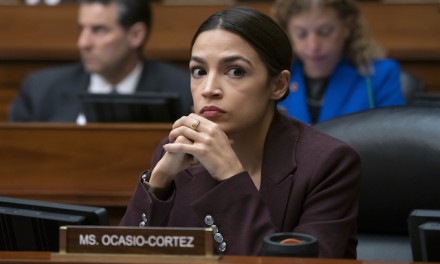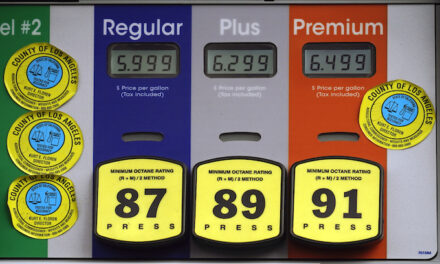Planting trees. Investing in transit and walkable neighborhoods. Pursuing local solar projects while limiting the use of natural gas.
The San Diego region has talked a lot about shrinking its carbon footprint. However, over the last five years, plans to cut planet-warming emissions have been slow and frequently marked by litigation.
Now newly elected leaders, such as county Supervisor Nathan Fletcher and San Diego Mayor Todd Gloria, are promising to get tougher on fossil fuels.
“The reality is that our greenhouse gas emissions are not on the right tract, and that’s not only in San Diego County or California,” Fletcher said at a public hearing Wednesday. “That’s the whole country.”
Greening up the San Diego region will not be easy, especially with unionized workers fearing they could lose their livelihoods and skyrocketing housing costs complicating efforts to build near job centers.
To drive home the point, Supervisor Jim Desmond recently called for tracking the financial impacts of climate policy on new home construction. He suggested that environmental restrictions on rural development, intended to limit tailpipe emission, could have the opposite effect as San Diego workers seek cheaper housing in Mexico and Riverside County.
“I believe in a balanced approach to our housing and our climate action goals,” the conservative leader said at a recent hearing. “The more regulations we add, unfortunately, housing prices go up and our workforce moves farther and farther away.”
Local leaders, increasingly dominated by Democrats, said they’re ready to take on the challenge. Specifically, the city and county of San Diego are overhauling key blueprints known as climate action plans, while officials at the Port of San Diego are pushing the maritime industry to electrify tucks, tugboats and cargo-handling equipment.
Gloria’s team recently announced it would boosting staffing for climate efforts and reevaluating the way it tracks progress. Officials said they also plan to consider placing restrictions on natural gas in new buildings. A draft is expected this fall.
“Over the next several months, we are taking a thoughtful approach on how we should calculate and track data, increase our focus on climate equity and implement meaningful steps we can take to reduce emissions more quickly, such as increasing safe options for people to walk or bike,” Gloria said in an email.
The county is also partnering with UC San Diego to spearhead an ambitious new regionwide campaign to zero out carbon emissions by 2035. That effort could get a significant boost from proposed legislation authored by state Assemblyman and former San Diego City Councilman Chris Ward. The bill, AB 897, would provide funding and technical assistance to help establish “regional climate networks.”
“There are glimmers of hope,” said Nicole Capretz, executive director of the San Diego-based Climate Action Campaign, “but there’s still a lot of headwinds.”
Capretz and her supporters have recently starting calling on cities in the region to limit the use of natural gas in new home construction. In California dozens of municipalities, starting with Berkeley in 2019, have passed ordinances encouraging or requiring newly built homes to rely on electricity for heating and cooking.
“Every day, families are exposed to harmful indoor air pollution and our climate emergency worsens, as methane gas seeps from pipes in buildings to our atmosphere,” said Matthew Vasilakis, a policy director with Climate Action Campaign.
Encinitas is now exploring the idea of restricting the use of natural gas in new homes, and the prospect that other cities will follow suit has made organized labor very uneasy. Kelvin Barrios, a spokesman for Laborers International Union of North America, local No. 89 voiced his concerns on Wednesday to the county Board of Supervisors. The union represents about 3,800 local construction workers throughout San Diego, including some who specialize in gas projects.
“We are here today to express our strong opposition to any policy framework that may push for the decarbonization of buildings without robust outreach to the workers that are most impacted,” he said. “We are looking ahead, and we could lose 20 percent of our workforce.”
Elected officials appear to be taking that message seriously. The county is expected to release a draft “green jobs plan” by the end of the year, aimed at helping workers transition as the region shifts away from fossil fuels.
Meanwhile, there’s a growing recognition that climate change has already started to impact the region, from the crumbling cliffs in Del Mar to wildfires to punishing heatwaves. Along with curbing emissions, many are now calling for programs to shield the most vulnerable residents, many of whom are grappling with rising utility bills.
A study from UCSD in July found that across the country low-income communities of color suffer from significantly more “urban heat” compared to wealthier and predominantly white neighborhoods, largely due to a lack of tree cover.
“The reality is that we have a deficit in parks, open spaces and tree canopy,” said Supervisor Nora Vargas. “I think it’s really critical for us to refine tree canopy goals for carbon sequestration, for healthier and stronger communities.”
The conversation around climate change has come a long way since last summer, when the 4th District Court of Appeal struck down the county’s previous blueprint for battling greenhouse-gas emissions. The climate plan — which relied heavily on the use of dubious carbon offsets — had been repeatedly challenged in court by the Sierra Club, Center for Biological Diversity and Climate Action Campaign, with the backing of then-California Attorney General Xavier Becerra.
For years, the county, led by supervisors such as Ron Roberts and Greg Cox, attempted to push through large master-planned housing projects on undeveloped land in high-fire areas. Officials tried to get around environmental restrictions by allowing developers to buy carbon credits to fund anything from methane digesters on dairy farms to conservation programs in the Amazon rainforest.
The courts repeatedly ruled that, among other things, the proposed carbon-canceling program lacked sufficient oversight and violated the county’s own goal of reducing emissions within the San Diego region.
“I want to make sure we get involved in actual reduction in greenhouse gas, not just checklists that suggest we should do some nice things,” said Peter Andersen with the San Diego chapter of the Sierra Club.
As the county redrafts its climate plan, officials said they may still consider the use of offsets to fund local projects. The region currently has only one such endeavor, the Cuyamaca Rancho State Park Reforestation Project, which is attempting to grow pine trees where forests were obliterated in the 2003 Cedar Fire.
The city of San Diego has also stumbled in recent years after initially promising big reductions in climate pollution.
Then-Mayor Kevin Faulconer made quite a splash in 2015 when he committed the city to using 100 percent renewable energy by 2035. However, efforts to cut emissions during his tenure proved less exciting.
The city’s tree-planting program, for example, barely got off the ground. Canopy cover has been stuck around 13 percent for years, missing a 2020 target for 15 percent.
Recycling efforts have also lagged, with the city missing a 2020 target to divert 75 percent of waste from the landfill. New efforts to collect compost, recently announced by Gloria, should achieve the milestone by the end of next year.
Most notably, the city set a target for 22 percent of people in its most urban areas to commute by biking walking or taking transit by 2020. During Faulconer’s term, the city never established how to track these commuters. No data is available from the city.
While Faulconer repeatedly claimed to cut greenhouse gas emission by 25 percent over the last decade, a Union-Tribune analysis exposed flaws in the city’s calculation as early as 2017.
Officials under Mayor Gloria have since acknowledged the carbon accounting error, which made it falsely seem as if the city had removed hundreds of thousands of cars off the road. The issue stems from the use of outdated driving projections data.
Perhaps it shouldn’t be surprising that the Sustainability Department has only had four full-time positions working on the climate plan, according to a report released in February by San Diego City Auditor Andy Hanau. The audit of the city’s climate plan found that staff lacked the authority and resources to influence or effectively coordinate between departments.
Now the city will need to hustle if it still wants to be the region’s leader on renewable power. The city of Encinitas plans to contract for 100 percent green energy by May, leaving San Diego’s once-ambitious goal to go all green by 2035 in the dust.
The feat is made possible by San Diego Community Power, a public energy alternative Encinitas formed with the cities of San Diego, Chula Vista, La Mesa and Imperial Beach.
Under the alternative system known as community choice aggregation, or CCA, elected officials can largely control where homes and businesses get their power, deciding whether to ink deals with natural gas plants or solar and wind farms. Traditionally, that’s been the sole domain of utilities, such as San Diego Gas & Electric. SDG&E also offers a 100 percent renewable plan but doesn’t have the authority to enroll entire cities.
The goal of CCAs has largely been to invest ratepayer dollars in new local renewable-energy projects. San Diego Clean Power, which was formed in 2019 has, for example, inked deals with three such projects in Southern California, all slated for completion in 2023.
That includes plans for a roughly 600-acre solar farm near Jacumba Hot Springs — which has itself driven home the challenges facing big-swing environmental transformation. As if on cue, residents of the desert outpost have started expressing concerns about the massive proposed solar farm and requesting its size be cut in half.
This story originally appeared in San Diego Union-Tribune.
©2021 The San Diego Union-Tribune. Visit sandiegouniontribune.com. Distributed by Tribune Content Agency, LLC.
—-
This content is published through a licensing agreement with Acquire Media using its NewsEdge technology.



















COVID is rearing its ugly head, California fires are burning half the state, People cannot afford the gas to get them to work and home, while criminals roam the streets unmolested and unprosecuted,,, Socialist sob sisters, and the social slobberers insist on compassion be shown to the muggers, the dope fiends, the throat slashers, to the prostitutes, the dope dealers, the homosexuals, transgender mental misfits so that today the decent man is completely off the reservation for no preservation,,,,,and these California Fossil fuel obsessed Fossil brains want us all to hug trees? These society killers of false compassion show more compassion not to humans but the plants, not the mugged, but the mugger, not to the family of the murdered, but the murderer, not to the woman who was raped, but the rapist, not to the poor girl who is given a shot of dope followed by impregnation, but the rich boy like Hunter who happens to come from a rich family. Carbon makes up about 18% of the human body yet they treat it as an enemy. How such people even got a voice, let alone political positions of power, goes to show just how far this nation has already slid into the valley of social insanity, death and decay. Apparently, their idea of human progressivism is we all put down our plows and go back into the trees with the apes where the law of the Jungle rules supreme.
I have a great way to help San diego out with this.. SHUT EVERY MILITARY BASE DOWN IN CA.. AND MOVE THEM all!
“Vow to get tough on climate”. Good luck with that.
Mortal beings—recognize who and what you are and stop trying to play God. You are making fools of yourselves and you will lose. The climate is what it is at any given time—you will learn to adapt to it as necessary as it changes—and the natural world will go on as it was designed to do.
beat me to it son of thunder.
Plant trees.
You’d think, with the SHEER # of forest fires CA has had over the past 10 years, THERE WOULD BE NO TREES left in ca to burn.
Getting rid of natural gas. In other words, no air conditioning in the summer and no heat in the winter, when it is 55 degrees out. Have fun in your sleeping bags in the winter and being in your bathing suits in the summer in your homes, when your homes heat up to 120 degrees.
Sunny California where insanity reigns supreme, governed by those who would be housed in asylums in places where the populace still has it’s sanity.
San diego USED TO be one of the few RED areas in Commiefornia.. NOW EVEN THAT city has joined the insane left…